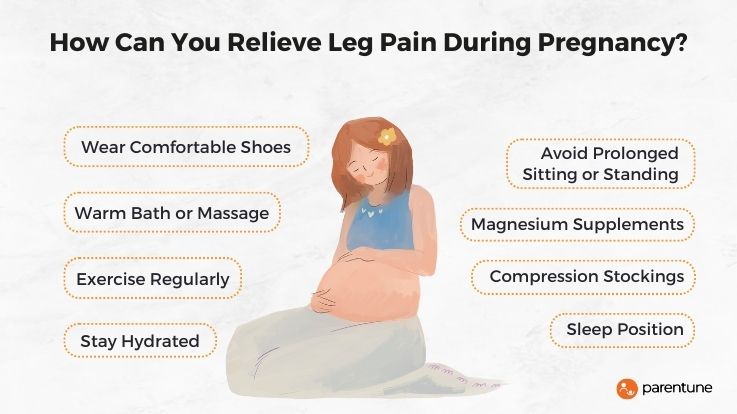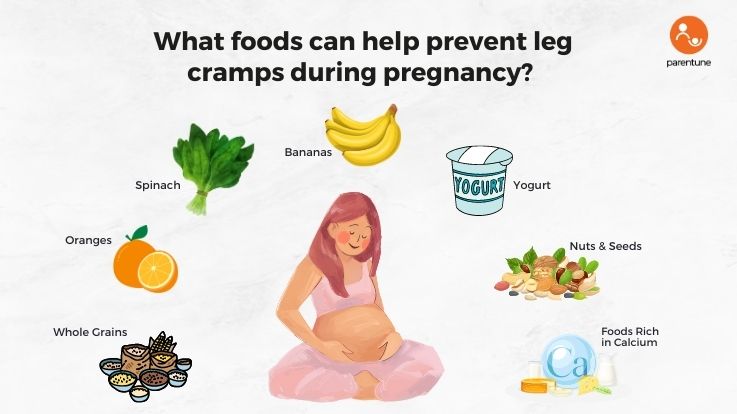Leg Cramps During Pregnancy: Causes & How To Relieve It

Only For Pro
Reviewed by expert panel
Are you experiencing uncomfortable leg cramps during your pregnancy journey? You're not alone. Expecting a baby is exciting but can bring its fair share of discomfort. One such discomfort may be leg pain during pregnancy, which can be particularly annoying during the first trimester. Whether it's waking up in the middle of the night due to painful leg cramps or dealing with leg pain during the early stages of pregnancy, you're not alone. In this blog, you’ll find out why these leg cramps occur and how you can find relief.
What is the Main Cause of Leg Cramps in Pregnancy?
"Leg cramps during pregnancy might be caused by fatigue, the uterus pressing on certain nerves, or decreased circulation in your legs from the pressure of the baby on blood vessels." - American Pregnancy Association

The main cause of leg cramps during pregnancy is a combination of factors related to the changes happening in the body as it adapts to support the growing baby. These factors include:
1. Extra weight: The additional weight you carry during pregnancy puts more strain on your leg muscles, causing them to cramp.
2. Reduced Circulation: As the uterus expands, it puts pressure on the blood vessels in the legs, leading to reduced circulation. This can result in muscle cramps and discomfort.
3. Nerve Compression: The expanding uterus can also compress nerves that supply the muscles in the legs, causing them to contract involuntarily and leading to cramps.
4. Hormonal Changes: Pregnancy hormones, particularly progesterone, can affect muscle tone and relaxation. Increased levels of progesterone can lead to muscle spasms and cramps.
5. Mineral Imbalances: Fluctuations in mineral levels, such as calcium and magnesium, can contribute to muscle cramps. During pregnancy, there may be changes in the body's ability to absorb and regulate these minerals, which can increase the likelihood of leg pain during pregnancy.
While the exact cause of leg cramps during pregnancy may vary from woman to woman, the factors mentioned above are commonly associated with this discomfort. It's important to consult with your healthcare provider if you experience severe or persistent leg cramps to rule out any underlying conditions and receive appropriate guidance for relief.
Is it normal to have pain in legs during pregnancy?
“Up to 30% of pregnant women experience leg pain in the first trimester”
Yes, experiencing leg pain during pregnancy, especially in the first trimester, is a common occurrence. It can be from mild range discomfort to excruciating pain. Many women report experiencing leg pain pregnancy first trimester, which can continue to persist or even intensify in the later stages of pregnancy.
“Leg cramps are often considered a normal part of the pregnancy journey. But while they're common, they can also be a sign of underlying issues like dehydration or mineral deficiencies, so it's always best to discuss them with your healthcare provider.”
How Can You Relieve Leg Pain During Pregnancy?
Relieving leg pain during pregnancy is a common concern for many expectant mothers. Fortunately, there are several strategies you can try to reduce leg pain and promote overall comfort. Here are some effective ways to relieve legs pain during pregnancy:

1. Stay Hydrated: Proper hydration can help reduce cramps. Make sure to drink enough water throughout the day.
2. Exercise Regularly: Gentle exercises like walking or prenatal yoga can significantly reduce leg cramps during pregnancy. It improves circulation and reduces leg pain in early pregnancy.
3. Magnesium Supplements: Studies have suggested that magnesium can help relieve cramps. It's always best to consult your healthcare provider before starting any new supplements.
4. Stretch Your Legs: Try to stretch your legs when resting. This can help improve blood circulation and reduce swelling and discomfort.
5. Wear Comfortable Shoes: Wearing comfortable, supportive footwear can help alleviate leg pain pregnancy first trimester.
6. Warm Bath or Massage: A warm bath or a gentle massage can soothe cramping muscles and provide relief from leg pain during pregnancy.
7. Avoid Prolonged Sitting or Standing: Try to avoid long periods of sitting or standing in one position. Take frequent breaks to stretch your legs and change positions to promote better circulation.
8. Changing your Sleep Position: When sleeping, try lying on your left side to improve blood flow to the lower extremities. Place a pillow between your legs for added support and comfort.
9. Compression Stockings: Consider wearing compression stockings or socks specifically designed for pregnancy. These can help improve circulation and reduce swelling and discomfort in the legs.
Note: While leg cramps in pregnancy are common, sudden or severe pain should not be ignored. If you're experiencing intense discomfort, it's crucial to seek immediate medical attention.
How Many Weeks Pregnant Do You Get Leg Cramps?
As your body changes during pregnancy, you may start to notice new pains and discomforts. One of the most common of these is leg cramps during pregnancy. These cramps can start as early as the first trimester, but they are most commonly experienced in the second and third trimesters. The frequency and intensity of these cramps can vary greatly from person to person.
Many pregnant women report experiencing their first leg pain pregnancy first trimester, but it's not uncommon to feel them later on as well. Leg cramps can become more frequent as the pregnancy progresses, often peaking in the third trimester.
It's important to remember that every pregnancy is unique, and so is every woman's experience with leg cramps. While most women will experience leg cramps in pregnancy at some point, some may not have them at all.
What foods can help prevent leg cramps during pregnancy?
If you're experiencing leg pain during pregnancy or leg cramps in pregnancy, certain dietary changes may help. It's important to consume nutrients that support muscle function and blood circulation.

1. Bananas: Rich in potassium, bananas can help prevent muscle cramps. Potassium plays a vital role in muscle function and can help maintain proper muscle contractions.
2. Spinach: Leafy greens like spinach are a good source of magnesium, which is important for muscle relaxation and function. Including spinach in your meals can help prevent muscle cramps, including those in the legs.
3. Yogurt: Yogurt is a great source of calcium, which is essential for muscle contraction and relaxation. It also provides other beneficial nutrients like protein and probiotics.
4. Oranges: Oranges are not only refreshing but also rich in vitamin C and potassium. Vitamin C aids in collagen production, which supports healthy muscles, while potassium helps prevent muscle cramps.
5. Whole Grains: Opt for whole grain foods like brown rice, whole wheat bread, and oats. These foods provide B vitamins and magnesium, which support muscle function and can help reduce leg cramps.
6. Nuts and Seeds: Almonds, walnuts, sunflower seeds, and pumpkin seeds are excellent sources of magnesium and other beneficial nutrients. Snacking on these foods can provide relief from leg cramps.
7. Foods Rich in Calcium: Calcium aids in the proper functioning of your muscles. Consuming dairy products, fortified foods, and leafy greens can enhance your calcium intake.
Remember, maintaining a well-rounded and varied diet is important during pregnancy. Consult with your dietitian for personalized advice on your specific nutritional needs and any dietary restrictions you may have. They can help you create a meal plan that supports a healthy pregnancy and helps prevent leg cramps.
What stretches can You do to relieve leg cramps during pregnancy?
Here are some gentle stretches that can be beneficial in relieving leg pain during pregnancy, particularly if you're in your first trimester and already dealing with leg pain in early pregnancy:
1. Standing Calf Stretch:
- Stand facing a wall with your hands on the wall at shoulder height.
- Take a step back with one leg, keeping it straight.
- Lean forward slightly, bending the front knee, and keeping the back heel on the ground.
- You should feel a gentle stretch in the calf of the back leg.
- Hold the stretch for 20-30 seconds and then switch sides.
2. Standing Hamstring Stretch:
- Stand straight with your feet hip-width apart.
- Place one foot on a raised surface, such as a low step or stool.
- Keeping your back straight, gently lean forward from your hips, extending your hands towards the raised foot.
- You should feel a gentle stretch in the back of the thigh (hamstring) of the elevated leg.
- Hold the stretch for 20-30 seconds and then switch legs.
3. Seated Calf Stretch:
- Sit on the floor with your legs extended in front of you.
- Use a towel or exercise band to loop around the ball of one foot.
- Gently pull the towel or band towards you while keeping your leg straight.
- You should feel a stretch in your calf muscle.
- Hold the stretch for 20-30 seconds and then switch legs.
4. Ankle Circles:
- Sit on a chair or the edge of a bed with your legs extended.
- Lift one foot off the ground and rotate your ankle in a circular motion.
- Perform 10 clockwise circles, then 10 counterclockwise circles.
- Repeat with the other foot.
5. Toe Flexes:
- Sit on the floor with your legs extended in front of you.
- Bend your toes and foot upward toward your body, feeling the stretch in your calf muscles.
- Hold for a few seconds, then relax and repeat the movement several times.
Following these simple tips and exercises can significantly reduce your discomfort and make your pregnancy journey more comfortable. If you experience any pain or discomfort, stop the stretch and consult your Doctor. It's always important to listen to your body and modify or avoid any stretches that don't feel suitable for you. Seek advice, stay informed, and make the best choices for you and your little one.
Enjoy this journey and take care of your body. You're doing a great job, mama!
Be the first to support
Be the first to share
Comment (0)
Related Blogs & Vlogs
No related events found.
Loading more...